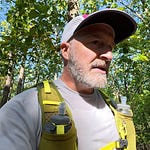After 25 years away from serious mountain biking, I made what might seem like a backwards decision: I chose flat pedals over clipless for my return to technical terrain. This wasn’t about comfort or convenience—it was a deliberate choice and a reminder of how skill rebuilding sometimes requires stepping back to move forward safely.
The decision came down to honest assessment versus ego. My mountain bike skills were rusty, my technical fitness was low, and I was riding trails I hadn’t touched in decades. In those conditions, the ability to quickly disconnect from the bike mattered more than power transfer efficiency. This represents a key principle in methodical training: match your equipment choices to your current capabilities, not your past performance or future goals.
During the brick workout—8+ miles of mountain biking followed by a 5K run—this tactical choice proved correct. On climbs where I would have normally powered through with clipless engagement, I found myself walking sections that challenged my current skill level. Rather than risk a crash while trying to unclip under pressure, flat pedals let me dismount quickly and safely when the terrain exceeded my abilities.
The changes in technology over the past 25 years have made the transition interesting. Modern 1x gearing felt almost electric compared to older mountain bike drivetrains, making climbs more manageable even without the pulling advantage of clipless pedals. Some hills that previously required zone 5 efforts now felt sustainable, suggesting that equipment evolution can partially compensate for fitness gaps during comeback phases.
The run portion revealed how brick workouts test real transition fitness. Those first steps off the bike carried heavy legs loaded with lactic acid from the climbing efforts. The research suggesting stride rhythm takes a mile to mile-and-a-quarter to normalize proved accurate—by halfway through the 5K, my legs had found their natural cadence despite the bike-induced fatigue.
What surprised me was the overall workout time. The 5K came in under 40 minutes despite feeling deliberately slow, suggesting that perceived effort during brick transitions doesn’t always match actual pace. This disconnect underscores why objective metrics, rather than subjective feelings, can be used as an advantage when evaluating a comeback to training.
The tactical lesson extends beyond mountain biking. When rebuilding any skill after an extended time away, equipment choices should serve current abilities rather than previous standards. The goal isn’t to immediately return to peak performance—it’s to create conditions where you can safely rebuild the foundation for future advancement.
My next step involves a phased return to clipless pedals, but only after confirming that my fundamental bike-handling skills have returned. This approach might take longer than ego would prefer, but it builds lasting confidence rather than temporary performance gains.
Your Next Step: If you’re returning to any technical sport after time away, audit your equipment choices honestly. What worked at your previous skill level might not serve your current rebuilding phase. Choose gear that matches where you are now, not where you used to be or hope to be soon.










